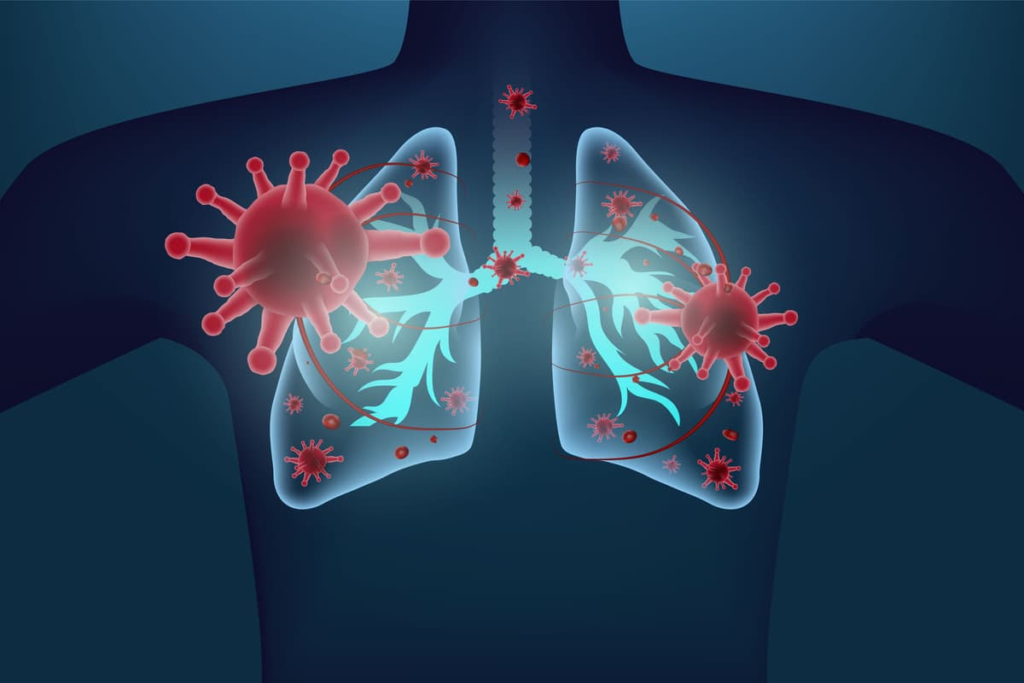By Rich Haridy
Research indicates newer COVID variants stemming from BA.2.86 can infect the lungs more effectively than any variant since Delta

Depositphotos
A newly published study from researchers at Ohio State University has found the recently emerged BA.2.86 variant of SARS-CoV-2 has a greater propensity for infecting certain lung cells than any prior Omicron variant. The research suggests BA.2.86 could potentially lead to COVID disease severity similar to the damaging 2021 Delta variant.
The SARS-CoV-2 variant BA.2.86 first emerged in August 2023. In a year completely dominated by the recombinant XBB and its broad family tree, this new variant stood out. It was the first notable viral lineage to come from the original BA.2 Omicron family tree in almost a year, and it seemed to appear out of nowhere.
For the most part researchers took a ‘watch and wait’ stance with BA.2.86. It seemed to display characteristics that could make it generate more severe disease but it carried those traits at a cost of decreased infectiousness. BA.2.86 was simply not as immune-evasive as XBB variants, so it was likely people with previously acquired immunity were able to effectively fight it off.
But with just one single mutation BA.2.86 turned into what was dubbed JN.1 and become incredibly immune-evasive. Within months JN.1 conquered the world and now as we move into 2024 it is the most dominant SARS-CoV-2 variant, triggering a massive wave of infections across the New Year period.
Newly published cell culture work has zoomed in on BA.2.86 in a bid to better understand how this novel coronavirus variant escapes antibodies and enters human cells. The research first effectively confirmed what prior epidemiological studies suggested: BA.2.86 is less immune evasive than XBB variants. So at least before it shifted to JN.1 it was unlikely to become dominant.
Of greater concern, however, are the findings showing BA.2.86 has an increased ability to infect lung cells called CaLu-3 cells. These are cells in the lower lung which are lined with a surface protein dubbed TMPRSS2.
SARS-CoV-2 generally enters human cells by slipping through two different surface proteins: ACE2 and TMPRSS2. When the virus mutated into its Omicron form it began to prioritise ACE2 cellular entry. This made the virus both more transmissible and less severe, accounting for Omicron’s milder disease characteristics.
According to Shan-Lu Liu, senior author on the latest study, BA.2.86 can get into CaLu-3 lung cells better than any COVID variant since Delta. And this means the viral sub-lineage could lead to more severe disease compared to prior Omicron or XBB variants.
“… BA.2.86 appears to have increased infectivity of human lung epithelial cells compared to all omicron variants, so that’s a little worrisome,” Liu said. “And, consistent with infectivity, it also has increased fusion activity with human lung epithelial cells. That raises a potential concern about whether or not this virus is more pathogenic compared to recent Omicron variants.”
So far, according to the CDC’s latest report, there is no evidence to indicate JN.1 is leading to more severe disease compared to other circulating variants. However, Liu is a little more circumspect, noting BA.2.86’s ability to infect certain lung cells has been a marked trait in earlier severe SARS-CoV-2 variants. And with such vast levels of infection in the world at the moment it is likely the virus will continue to mutate in directions that could lead to more severe disease.
“The concern is whether or not this variant, as well as its descendants including JN.1, will have an increased tendency to infect human lung epithelial cells similar to the parental virus that launched the pandemic in 2020,” explained Liu. “We know that coronaviruses are prone to viral recombination, which can lead to new variants with huge numbers of mutations that could have increased immune evasion but also disease severity. That’s why surveillance of the variants is still very important, even though we are in the end of year four of the pandemic.”
The new study was published in the journal Cell.
Source: Ohio State University

Leave a Reply